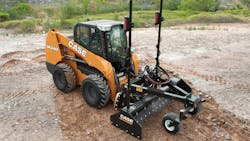Key Highlights
In this article, you'll learn:
- Risks to pneumatic tires on skid steers.
- How to use a visual inspection.
- Key operator tips.
When it comes to pneumatic tires, most anything can be a puncture risk.
Because of the skid steer loader's usefulness in all manner of cleanup operations, that risk multiplies. But a little proactive maintenance and inspection can go a long way toward avoiding extra downtime and extra costs.
Case dealer Luby Equipment provides a handy guide to skid steer tire maintenance.
Keep tires clean
Hose down your tires routinely so they are easy to inspect. Look for bubbles, bumps, cracks, and anything that might be lodged in the rubber.
Check the tread on skid steer loaders
A quick visual inspection will also reveal any uneven wear. On skid steers, one set of tires may wear faster (the front or rear), depending on how they are operated. Rotate the tires as soon as you notice any uneven wear, which will extend the life of all four tires.
Operate a skid steer with four tires engaged
There is less wear on the tires and the machine when the skid steer is operated with all four tires engaged on the ground. When the bucket is too far beneath a load, the front tires may lift slightly off the ground, placing stress on the back tires.
Keep skid steer tires off the road
Skid steer tires are designed for operation on ground, not on road surfaces. Consequently, the tires will wear out faster when they are driven on roads rather than on the ground.
Watch for debris when operating skid steers
Skid steers are operating in areas that can be full of debris. Drive carefully to avoid objects.
More on skid steer loaders
- When to consider solid, flat-proof tires.
- Top skid steers less than 2,000 ROC.
- Best practices for trailering compact equipment.
- Machine control systems can save time and money when deployed on smaller machines.
- Uptime tips for skid steer loaders.
Use retaining rims on skid steers
Avoid popping off retaining rims, which can occur by catching the rim on an object. It's expensive to replace a rim alone, never mind the downtime the unnecessary maintenance causes. Consider tires with rim protectors built into the design.
Monitor skid steer tire pressure
If the tire pressure is too low, you will waste fuel; if it's too high, you increase the chance of flats. Either way, uneven wear can result. Keep a reliable tire gauge in the cab and check the pressure every day, or once a week, depending on how many hours the skid steer operates. The owner's manual will tell you the correct tire-presure range.
How to store skid steer tires
Constant exposure to sunlight can cause tires to expand and crack. Store them in a cool, dry place.
Buy consistent brands
Avoid installing different brands or models of tires on the same machine. Each tire brand has its own distince design and combining brands can cause uneven wear on the tires and the skid steer.
About the Author
Frank Raczon
Raczon’s writing career spans nearly 25 years, including magazine publishing and public relations work with some of the industry’s major equipment manufacturers. He has won numerous awards in his career, including nods from the Construction Writers Association, the Association of Equipment Manufacturers, and BtoB magazine. He is responsible for the magazine's Buying Files.


